Toyota CH-R Service Manual: Operation Check
OPERATION CHECK
CHECK SMART KEY SYSTEM (for Entry Function) OPERATION
NOTICE:
Make sure that the smart key system (for Entry Function) has not been canceled before performing this inspection.
(a) Check the entry unlock function (driver door, front passenger door).
(1) Perform a wireless lock door operation to lock the door, touch the unlock sensor built into the backside of the front door outside handle assembly of the driver door while carrying the electrical key transmitter sub-assembly and check that the door unlocks.
(2) Inspect the entry unlock detection area. Hold the electrical key transmitter sub-assembly at the same height as the door outside handle assembly and approximately 0.7 to 1 m (2.30 to 3.28 ft.) from the vehicle as shown in the illustration and check that the LED (red) of the electrical key transmitter sub-assembly blinks.
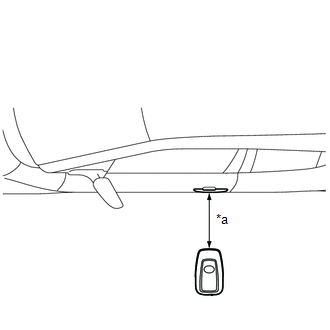
|
*a |
0.7 to 1 m (2.30 to 3.28 ft.) |
(3) With the system in unlock standby mode, grasp the front door outside handle assembly LH and check that the door unlocks.
HINT:
- The system is in unlock standby mode when the electrical key transmitter sub-assembly is in the detection area and the key ID code sent by the electrical key transmitter sub-assembly matches the key ID code stored by the certification ECU (smart key ECU assembly).
- Communication may not be possible if the electrical key transmitter sub-assembly is within 0.2 m (0.656 ft.) of the door outside handle assembly.
- Inspect the front passenger door using the same procedure.
(4) Check the unlock response sensitivity. With the system in unlock standby mode, touch the area shown in the illustration and check that the door unlocks.
NOTICE:
If the sensor is touched too quickly or released too slowly, the sensor may not react and the door will not unlock.
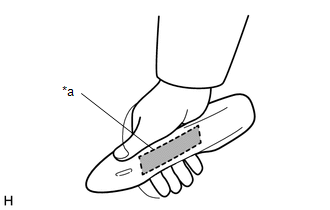
|
*a |
Unlock Sensor (Backside) |
HINT:
Inspect the front passenger door using the same procedure.
(b) Check the entry lock function (driver door, front passenger door).
NOTICE:
If the electrical key transmitter sub-assembly is in the vehicle but outside the detection area (on the instrument panel, in the glove box, on the floor) and a door lock operation is performed, the key lock-in prevention function will not operate and the electrical key transmitter sub-assembly will be locked inside the vehicle.
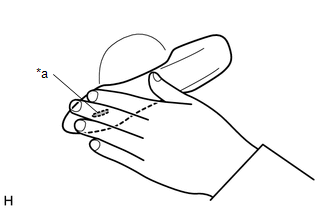
|
*a |
Lock Sensor |
(1) With the door closed and unlocked, touch the lock sensor of the front door outside handle assembly of the driver door while carrying the electrical key transmitter sub-assembly and check that the door locks.
HINT:
- If the door does not lock even when touching the lock sensor, touch it with your palm.
- Inspect the front passenger door, using the same procedure.
(2) Inspect the entry lock operating range. Hold the electrical key transmitter sub-assembly approximately 0.7 to 1 m (2.30 to 3.28 ft.) below the bottom edge of the door glass and approximately 0.3 m (0.984 ft.) from the vehicle as shown in the illustration, touch the lock sensor and check that the door locks.
HINT:
- If the door does not lock even when touching the lock sensor, touch it with your palm.
- As communication may not be possible if the electrical key transmitter sub-assembly is within 0.2 m (0.656 ft.) of the front door outside handle assembly, the door may not lock if the lock sensor is touched with the same hand that is carrying the electrical key transmitter sub-assembly, etc.
- If the key lock-in prevention function buzzer sounds, radio waves from the indoor electrical key antenna may be leaking from the vehicle.
- Inspect the front passenger door using the same procedure.
- The entry lock function cannot be operated more than 3 times consecutively.
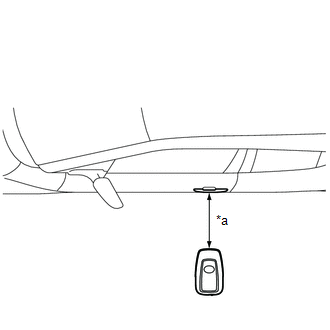
|
*a |
0.7 to 1 m (2.30 to 3.28 ft.) |
(c) Check the entry back door open function (back door opener switch).
(1) With the back door closed and locked, press the lock switch of the back door opener switch assembly while carrying the electrical key transmitter sub-assembly and check that the back door opens.
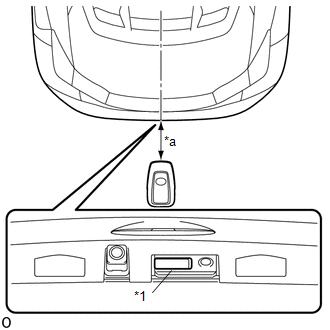
|
*1 |
Back Door Opener Switch Assembly (Open Switch) |
|
*a |
0.7 to 1 m (2.30 to 3.28 ft.) |
(2) Inspect the entry back door open operating range. Hold the electrical key transmitter sub-assembly at the same height as the rear bumper upper surface and approximately 0.7 to 1 m (2.30 to 3.28 ft.) from the vehicle as shown in the illustration, press the open switch of the back door opener switch assembly and check that the back door opens.
(d) Check the entry back door lock function.
NOTICE:
If the electrical key transmitter sub-assembly is in the vehicle but outside the detection area (on the instrument panel, in the glove box or on the floor) and a back door lock operation is performed, the key lock-in prevention function will not operate and the electrical key transmitter sub-assembly will be locked inside the vehicle.
(1) With the back door closed and unlocked, press the lock switch of the back door opener switch assembly while carrying the electrical key transmitter sub-assembly outside of the vehicle and check that the back door locks.
(2) Inspect the entry back door lock operating range. Hold the electrical key transmitter sub-assembly at the same height as the rear bumper upper surface and approximately 0.7 to 1 m (2.30 to 3.28 ft.) from the vehicle as shown in the illustration, press the lock switch of the back door opener switch assembly and check that the back door locks.
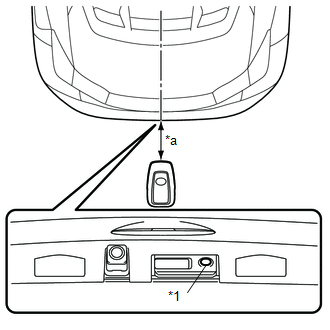
|
*1 |
Back Door Opener Switch Assembly (Lock Switch) |
|
*a |
0.7 to 1 m (2.30 to 3.28 ft.) |
HINT:
- Communication may not be possible if the electrical key transmitter sub-assembly is within 0.2 m (0.656 ft.) of the rear bumper.
- If the key lock-in prevention function buzzer sounds, radio waves from the indoor electrical key antenna may be leaking from the vehicle.
(e) Check the key lock-in prevention function (vehicle interior).
NOTICE:
In order to prevent the electrical key transmitter sub-assembly from being locked inside the vehicle, perform this inspection with the window of a door open.
(1) Turn the engine switch off.
(2) Place the electrical key transmitter sub-assembly on a front or rear seat.
(3) Close all of the doors and make sure they are unlocked.
(4) Touch a door lock sensor and check that the doors do not lock and the key lock-in prevention function buzzer (external) sounds for approximately 5 seconds.
(f) Check the transmitter battery saving function
(1) Press the unlock switch of the electrical key transmitter sub-assembly twice while pressing the lock switch and check that the LED of the electrical key transmitter sub-assembly blinks 4 times and enters transmitter battery saving mode.
(2) Check that the smart key system (for Entry Function) does not operate while in transmitter battery saving mode.
HINT:
To cancel transmitter battery saving mode, press a switch of the electrical key transmitter sub-assembly.
(g) Check the entry cancel function.
(1) Cancel the smart key system and check that all the functions of the smart key system (for Entry Function) no longer operate.
Click here .gif)
HINT:
While the smart key system is canceled, it is possible to lock and unlock the doors with the wireless function, and the engine can be started by holding the electrical key transmitter sub-assembly near the engine switch.
(h) Check the answer-back function (hazard warning light flashing and buzzer sounding*).
|
Entry Operation |
Hazard Warning Light |
Wireless Buzzer* |
|---|---|---|
|
Entry Lock |
Flashes once |
Sounds once |
|
Entry Unlock |
Flashes twice |
Sounds twice |
*: w/ Toyota Safety Sense P
KEY DIAGNOSTIC MODE (Using Techstream)
HINT:
- With key diagnostic mode, it is possible to check if the electrical key transmitter sub-assembly is operating properly with the selected electrical key antenna and within the selected detection area by the sounding of the wireless buzzer.
- If the buzzer sounds with [CH1] displayed but not with [CH2], the electrical key transmitter sub-assembly cannot be detected by channel 2 due to a malfunction, such as wave interference.
(a) Enter the following menus: Body Electrical / Smart Key / Utility / Communication Check (Key Diag Mode).
Body Electrical > Smart Key > Utility|
Tester Display |
|---|
|
Communication Check(Key Diag Mode) |
(b) Inspect the appropriate item according to the following table.
|
Tester Display |
Inspection Item |
|---|---|
|
[CH1/CH2] Overhead + Driver Side*1 |
Front door outside handle assembly LH (electrical key antenna) |
|
[CH1] Overhead + Driver Side*1 |
|
|
[CH2] Overhead + Driver Side*1 |
|
|
[CH1/CH2] Overhead + Passenger Side*2 |
Front door outside handle assembly RH (electrical key antenna) |
|
[CH1] Overhead + Passenger Side*2 |
|
|
[CH2] Overhead + Passenger Side*2 |
|
|
[CH1/CH2] Overhead + Front Room*3 |
No. 1 indoor electrical key antenna assembly (front floor) |
|
[CH1] Overhead + Front Room*3 |
|
|
[CH2] Overhead + Front Room*3 |
|
|
[CH1/CH2] Overhead + Back Door*4 |
Electrical key antenna (outside luggage compartment) |
|
[CH1] Overhead + Back Door*4 |
|
|
[CH2] Overhead + Back Door*4 |
|
|
[CH1/CH2] Luggage + Back Door (inside)*5 |
No. 3 indoor electrical key antenna assembly (inside luggage) |
|
[CH1] Luggage + Back Door (inside)*5 |
|
|
[CH2] Luggage + Back Door (inside)*5 |
|
|
[CH1/CH2] Immobiliser Amp*6 |
Amplifier (engine switch) |
|
[CH1] Immobiliser Amp*6 |
|
|
[CH2] Immobiliser Amp*6 |
- [CH1]: Channel 1 is set.
- [CH2]: Channel 2 is set.
- [CH1/CH2]: Channel 1 and 2 switch automatically at a specific interval*.
*: If the electrical key transmitter sub-assembly is detected with either channel 1 or 2, the buzzer sounds.
(c) Bring the electrical key transmitter sub-assembly near the selected electrical key antenna and check that the wireless buzzer sounds.
(1) *1: Front door outside handle assembly LH
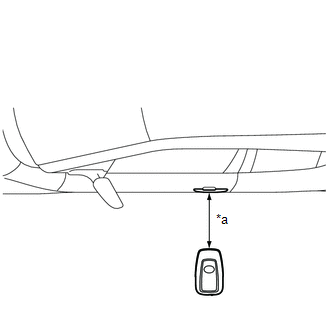
|
*a |
0.7 to 1 m (2.30 to 3.28 ft.) |
HINT:
- Hold the electrical key transmitter sub-assembly at the same height as the front door outside handle assembly in the position shown in the illustration.
- *2: Perform the same inspection for the front passenger door.
(d) *3: No. 1 indoor electrical key antenna assembly (front floor)
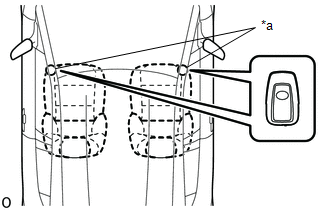
|
*a |
Inspection Point |
HINT:
Place the electrical key transmitter sub-assembly on the front seat cushion of the driver seat or front passenger seat.
(e) *4: Electrical key antenna (outside luggage compartment)
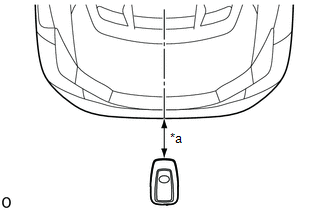
|
*a |
0.7 to 1 m (2.30 to 3.28 ft.) |
HINT:
Hold the electrical key transmitter sub-assembly at the same height as the rear bumper upper surface and align it with the center of the rear of the vehicle as shown in the illustration.
(f) *5: No. 3 indoor electrical key antenna assembly (inside luggage compartment)
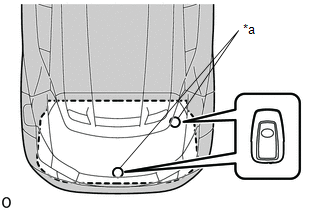
|
*a |
Inspection Point |
HINT:
Place the electrical key transmitter sub-assembly on the luggage room floor.
(g) *6: Amplifier (engine switch)
HINT:
While facing the logo side of the electrical key transmitter sub-assembly toward the engine switch, hold the transmitter near the engine switch.
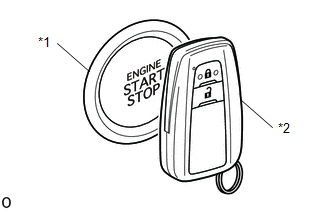
|
*1 |
Engine Switch |
|
*2 |
Electrical Key Transmitter Sub-assembly |
 System Description
System Description
SYSTEM DESCRIPTION
MULTI CHANNEL FUNCTION
(a) The electrical key transmitter sub-assembly and electrical key and TPMS receiver
assembly can operate on two different RF channels. When an electrical ...
 Customize Parameters
Customize Parameters
CUSTOMIZE PARAMETERS
CUSTOMIZE SMART KEY SYSTEM (for Entry Function)
HINT:
The following items can be customized.
NOTICE:
When the customer requests a change in a function, first make sur ...
Other materials:
Toyota CH-R Service Manual > Pre-collision System: Freeze Frame Data
FREEZE FRAME DATA
DESCRIPTION
(a) When a pre-collision system DTC is stored, the millimeter wave radar sensor
assembly stores the current vehicle (ECU or sensor) state as Freeze Frame Data.
CHECK FREEZE FRAME DATA
(a) Connect the Techstream to the DLC3.
(b) Turn the ignition switch to ON.
(c ...
Toyota CH-R Service Manual > Airbag System: Short in Curtain Shield Squib RH Circuit (B1830/57-B1833/57)
DESCRIPTION
The curtain shield squib RH circuit consists of the airbag sensor assembly and
curtain shield airbag assembly RH.
The airbag sensor assembly uses this circuit to deploy the airbag when deployment
conditions are met.
These DTCs are stored when a malfunction is detected in the curta ...
Toyota C-HR (AX20) 2023-2026 Owner's Manual
Toyota CH-R Owners Manual
- For safety and security
- Instrument cluster
- Operation of each component
- Driving
- Interior features
- Maintenance and care
- When trouble arises
- Vehicle specifications
- For owners
Toyota CH-R Service Manual
- Introduction
- Maintenance
- Audio / Video
- Cellular Communication
- Navigation / Multi Info Display
- Park Assist / Monitoring
- Brake (front)
- Brake (rear)
- Brake Control / Dynamic Control Systems
- Brake System (other)
- Parking Brake
- Axle And Differential
- Drive Shaft / Propeller Shaft
- K114 Cvt
- 3zr-fae Battery / Charging
- Networking
- Power Distribution
- Power Assist Systems
- Steering Column
- Steering Gear / Linkage
- Alignment / Handling Diagnosis
- Front Suspension
- Rear Suspension
- Tire / Wheel
- Tire Pressure Monitoring
- Door / Hatch
- Exterior Panels / Trim
- Horn
- Lighting (ext)
- Mirror (ext)
- Window / Glass
- Wiper / Washer
- Door Lock
- Heating / Air Conditioning
- Interior Panels / Trim
- Lighting (int)
- Meter / Gauge / Display
- Mirror (int)
- Power Outlets (int)
- Pre-collision
- Seat
- Seat Belt
- Supplemental Restraint Systems
- Theft Deterrent / Keyless Entry
0.0104
